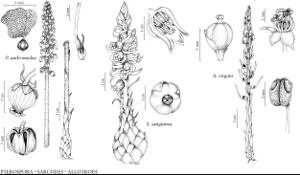Difference between revisions of "Pterospora andromedea"
Gen. N. Amer. Pl. 1: 269. 1818 ,.
Common names: Pinedrops ptérospore andromeda
Treatment appears in FNA Volume 8. Treatment on page 389.
FNA>Volume Importer |
FNA>Volume Importer |
||
| Line 46: | Line 46: | ||
|publication year= | |publication year= | ||
|special status= | |special status= | ||
| − | |source xml=https://jpend@bitbucket.org/aafc-mbb/fna-data-curation.git/src/ | + | |source xml=https://jpend@bitbucket.org/aafc-mbb/fna-data-curation.git/src/8f726806613d60c220dc4493de13607dd3150896/coarse_grained_fna_xml/V8/V8_735.xml |
|subfamily=Ericaceae subfam. Monotropoideae | |subfamily=Ericaceae subfam. Monotropoideae | ||
|genus=Pterospora | |genus=Pterospora | ||
Revision as of 18:08, 18 September 2019
Inflorescences 1.5–17 dm, glandular-hirsute; bracts 2–3.5 × 0.5–1 cm, scarious at maturity. Flowers: sepals 4–6 × 2–3 mm; corolla 6–9 mm, base not saccate, lobes reflexed, rounded to blunt; stamens 3–5 mm; anthers horizontal at anthesis, ca. 1 mm diam., awns to 1.5 mm; ovary 3–4 × 4–6 mm, glabrous; style 1–3 × 1 mm; stigma yellowish, ca. 1.5 mm diam. Capsules persistent, thin-segmented, remaining connate at apex, 5–10 × 7–14 mm. Seeds 0.2–0.5 mm including wing. 2n = 16, 48.
Phenology: Flowering summer.
Habitat: Moist to dry, often deep humus of mixed-deciduous or coniferous forests (sometimes on calcareous substrates)
Elevation: 60-3700 m
Distribution

Alta., B.C., N.B., Ont., P.E.I., Que., Sask., Alaska, Ariz., Calif., Colo., Idaho, Mich., Mont., Nebr., Nev., N.H., N.Mex., N.Y., Oreg., S.Dak., Tex., Utah, Vt., Wash., Wyo., Mexico (Chihuahua, Durango, Nuevo León).
Discussion
Selected References
None.
Lower Taxa
None.
